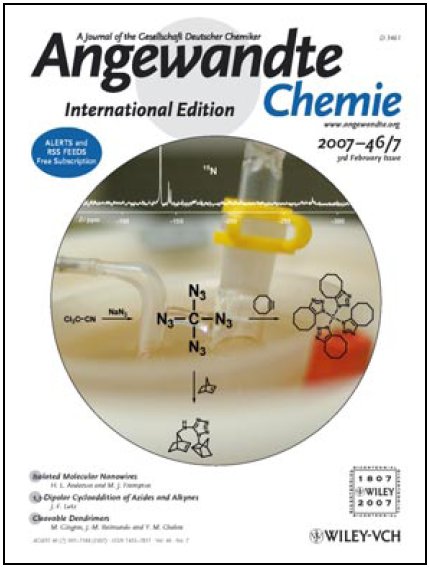chemoleo
Biochemicus Energeticus
    
Posts: 3005
Registered: 23-7-2003
Location: England Germany
Member Is Offline
Mood: crystalline
|
|
The Exciting Chemistry of Tetraazidomethane C(N3)4
The syntesis of tetraazidomethane, or carbon tetraazide, just came out very recently! I'd have never thought it'd be stable enough to exist, but not
so!
Its synthesis and applications made it to the cover of Angewandte Chemie:

From the cover:
| Quote: | Not only as an explosive but also in its sometimes surprising reactions,
tetraazidomethane proves to be an exciting substance. As shown in the cover picture,
the compound can be synthesized from commercially available trichloroacetonitrile in
one step, isolated by preparative gas chromatography as a limpid liquid, and
characterized by its 15N NMRspectrum measured with natural isotopic abundance.
Although a simple trapping product is formed in the presence of cyclooctyne,
tetraazidomethane undergoes a more complex transformation with norbornene.
Further reactions are described by K. Banert et al. in their Communication on
page 1168 ff. |
It is highly explosive, and in the article (attached) it gives on paragraph on safety concerns:
| Quote: | Tetraazidomethane (1) is extremely
dangerous as a pure substance. It can explode at any time—
without a recognizable cause. Less than a drop of this
compound isolated by gas chromatography is able to destroy
completely not only the glass trap but also the vacuum Dewar
flask of the cooling bath. Therefore, the isolated substance
should only be diluted by vapor deposition of a solvent behind
a safety shield rather than by manual handling (with a pipette
or syringe). However, solutions of 1 can also lead to an
explosion after mechanical stress (swivel closure) or after
evaporation of a volatile solvent, for example, in a pipette.
Finally, it should be considered that 3, 5, and 7 are also
explosive azides. |
Nothing to be trifled with, it sounds like another ethylperchlorate!
The synthesis is actually simple, it is direct substitution of trichloroacetonitrile (Cl3CCN) with N3 from NaN3.
The difficulty undoubtedly resides in its dangers!
Have a read and marvel at these guys!
[Edited on 7-4-2007 by chemoleo]
Attachment: tetraazidomethane.pdf (206kB)
This file has been downloaded 1212 times
Never Stop to Begin, and Never Begin to Stop...
Tolerance is good. But not with the intolerant! (Wilhelm Busch)
|
|
|
The_Davster
A pnictogen
      
Posts: 2861
Registered: 18-11-2003
Member Is Offline
Mood: .
|
|
Wow! Now that is cool. I love how it produces tri and tetrazoles upon reaction with double bonds. I would absolutely love to see what would happen
upon reaction with FOX-7 ( (NH2)2C=C(NO2)2 )
|
|
|
chemoleo
Biochemicus Energeticus
    
Posts: 3005
Registered: 23-7-2003
Location: England Germany
Member Is Offline
Mood: crystalline
|
|
There is however, it seems, a limitation to addition to double bonds - all the unsaturated compounds they use are somewhat strained, cyclooctin
certainly is, and the bornenes too. I'd think that this mechanism wouldnt work so readily unstrained compounds...
Never Stop to Begin, and Never Begin to Stop...
Tolerance is good. But not with the intolerant! (Wilhelm Busch)
|
|
|
hinz
Hazard to Others
  
Posts: 200
Registered: 29-10-2004
Member Is Offline
Mood: No Mood
|
|
Very interesting!
It's amazing that it works with trichloroacetonitrile and on the other hand it doesn't work with tetraiodomethane as most people would have rather
expect. Are there any reasons why it only works with Cl3-C-CN?
The preparation from Br3-C-Cl with NaN3 to (N3)3C-Cl and than the exchange of chlorine to azide with the super-levis acid SbCl5 seems even possible
for amateur chemists. Maybe someone courageous trys it too, like blaser with ethyl perchlorate.
The addition to double bond-mechanism should be more or less the same as the formation of the primary ozonides in ozonolysis. The double attacks the
formally positive charged N-atom and at the same time, the negative charged N-atom attacks nucleophilic the other, positive charged C.
|
|
|